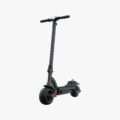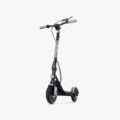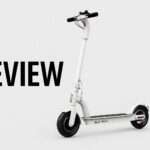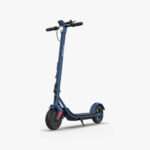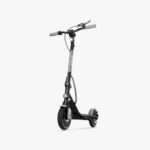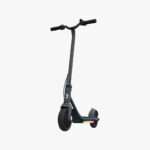- Home
- Scooters
- Electric Scooters
- Jetson Rhythm
Jetson Rhythm
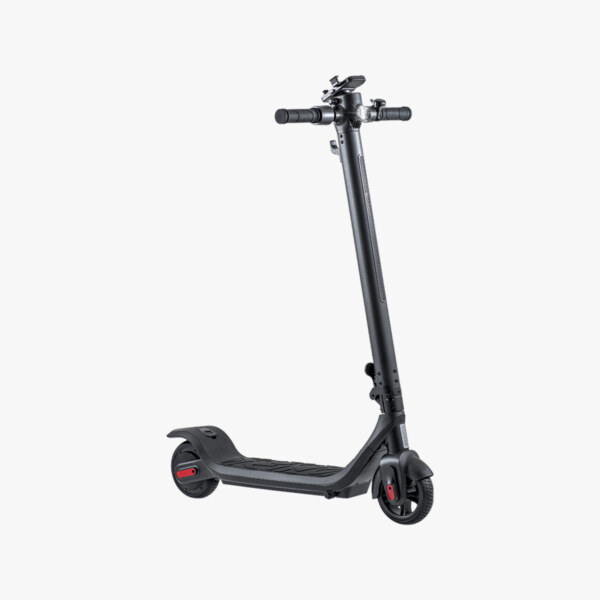

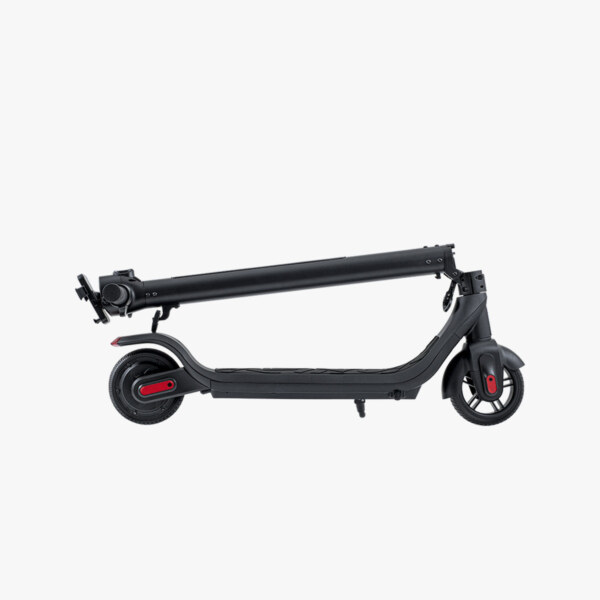
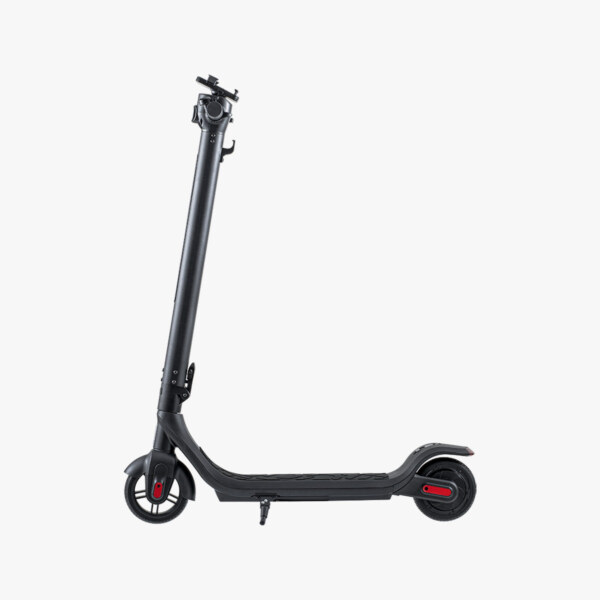
- Battery Range: 12 miles (19 km)
- Top Speed: 15.0 mph (24 km/h)
- Motor Power: 250 W
- Weight Capacity: 220 lb (100 kg)
- Charging Time: ≈6 h
- Scooter Weight: 30.0 lb (13.6 kg)
PROS
- 15.0 mph (24 km/h) top speed
- 12 miles (19 km) stated range
- 6.5 in solid tires
- LCD screen + phone holder
- Bluetooth speaker
- Kickstand and bell
CONS
- Short real-world range
- Solid tires can feel harsh
- No suspension
- No smartphone app

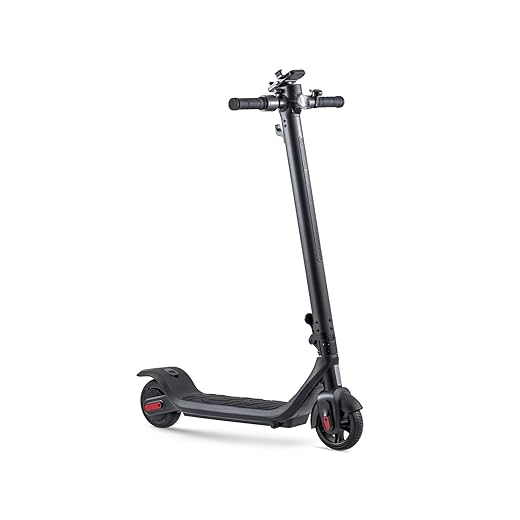
Key Takeaways
- The Jetson Rhythm is a compact folding electric scooter designed for short, practical trips.
- It features a 250 W motor, a 36V lithium-ion battery, and reaches speeds up to 15 mph, making it ideal for teens and lighter adults.
- With a weight of around 28 lb, it offers excellent portability and can easily fit in small spaces when folded.
- While it suits quick rides on smooth surfaces, it lacks power for steep hills and long commutes.
- Overall, the Jetson Rhythm combines useful features like a phone holder and Bluetooth speaker for a user-friendly experience.
Table of contents
- What Is the Jetson Rhythm?
- How the Jetson Rhythm Works
- Key Specifications
- Design & Build Quality
- Performance Fundamentals
- Battery, Range & Efficiency
- Ride Quality & Comfort
- Braking & Safety Features
- Portability & Daily Usability
- Maintenance & Care
- Weather & Seasonal Considerations
- Jetson Rhythm vs Alternatives
- Who the Jetson Rhythm Is (and Isn’t) For
The Jetson Rhythm is a compact folding electric scooter for quick, simple trips. It fits teens and lighter adults who want something easy, light, and not scary fast. It feels more like a daily gadget than a serious commuter machine, and that is how it should work. So if your rides stay short, smooth, and practical, this scooter slides into your routine without drama.
What Is the Jetson Rhythm?
The Jetson Rhythm is a small stand-up electric scooter with a folding stem, front hub motor, and low deck. It runs on a 36V lithium-ion battery and uses a thumb throttle, so control feels clear and direct from the first ride.
Top speed reaches up to 15 mph (24 km/h) in the fastest mode on flat ground with a lighter rider. That speed sits in a comfortable middle zone. It is quicker than toy scooters, but slower than larger commuter models that chase higher speed. The rated max rider weight is 220 lb (100 kg), and the design works best on paved paths, allowed sidewalks, and clean city streets.
The target rider looks like this. A student or teen who wants a first scooter that folds fast. A casual city rider who handles short rides and needs something that takes little space in a hallway, dorm, or trunk. So the Jetson Rhythm leans toward simplicity and low weight, not raw power.
How the Jetson Rhythm Works
The system stays simple on purpose.
A 250 W front hub motor handles drive. The 36V battery lives inside the deck. An electronic controller sits between them. When you press the thumb throttle, the controller feeds power to the motor, and the scooter starts to roll. When you ease off, power drops and the scooter coasts.
Now check the cockpit. The center display shows speed, battery level, and mode. A button swaps between three speed modes. The lowest mode keeps things slow and calm for first rides in a driveway or quiet street. The middle mode fits relaxed bike paths and short errands. The top mode unlocks the full rated speed for open, safe stretches.
Braking runs through an electronic brake lever. Pull the lever, and the system uses the motor to slow the wheel in a smooth curve. Light pull trims speed. Stronger pull gives firmer braking. The rear light reacts when you brake, so people behind get a clear signal.
Cruise control helps on steady flat runs. Hold a constant throttle for a short span, wait for the signal, then let your thumb rest while the scooter holds that pace. Tap the brake or throttle, and control jumps back to your hand. So everyday riding turns into a simple loop. Press, glide, brake, repeat.
Key Specifications
These details place the Jetson Rhythm inside the compact entry-level city scooter class.
| Category | Details |
|---|---|
| General | Brand: Jetson. Model: Rhythm. Type: folding electric scooter. Recommended age: 12+. Max rider weight: 220 lb (100 kg). Best for paved, even surfaces. |
| Performance & Power | Motor: 250 W front hub motor. Max speed: up to 15 mph (24 km/h) on flat ground. Claimed max range: up to 12 miles (19 km) in ideal conditions. Three riding modes for different comfort levels. |
| Battery, Charging & Electrical | Battery: 36V, 6Ah lithium-ion pack (around 216 Wh). 42V charger matched to the pack. Typical charge time: about 4–6 hours from low. Charge port on deck with protective cover. |
| Build & Dimensions | Approx weight: around 28 lb (12.7 kg). Tires: 6.5 in solid tires. Deck: about 17.5 x 5.0 in (44.5 x 12.7 cm). Unfolded: about 44 x 18.5 x 48 in (112 x 47 x 122 cm). Folded: about 44 x 18.5 x 17 in (112 x 47 x 43 cm). |
| Safety & Control | Electronic brake lever with motor braking. Rear brake light. Front light. Reflectors. Bell. Speed-limited modes to help new riders. |
| Features & Extras | LCD display. Cruise control. Integrated phone holder. Built-in Bluetooth speaker. Kickstand. Fast folding latch and hook system. |
| Warranty & Compliance | One-year limited warranty against manufacturing defects with normal use. Standard electrical and safety markings listed in product documentation. |
This mix lines up with what you expect from a light starter scooter, not a full daily workhorse.
Design & Build Quality
The Jetson Rhythm looks clean and friendly. The straight stem, low deck, and covered cables keep everything tidy. It has that grab-and-go feel when you pick it up or roll it out the door.
The low deck helps with balance. You stand close to the ground, so the scooter feels stable at low and moderate speeds. The deck gives enough length for a staggered stance. One foot in front, one turned slightly behind. Larger shoes fit, although space feels snug, which matches its compact role.
Plastic trim panels wrap parts of the frame. They hide wiring, soften edges, and give the scooter a finished look. When bolts stay tight and the folding latch clicks fully in place, the frame feels stable for short daily use.
Up front, the handlebar layout stays simple. The display sits in the middle. The phone holder stays nearby, though eyes still belong on the path, not the screen. Your right thumb falls on the throttle without reach. Your left hand handles the e-brake and bell. So you ride without hunting for controls.
Nothing feels fancy. It feels direct, simple, and light, which fits the idea.
Performance Fundamentals
The Jetson Rhythm rides like its numbers suggest.
From a stop, it does not jump. It eases into motion, so new riders get a moment to settle their stance. That calm start works well for teens and cautious riders.
On flat, smooth ground in top mode, it can reach its rated top speed with a lighter rider. Then it holds a steady pace that fits mellow bike lanes and shared paths where rules allow scooters. Steering feels quick, since the wheels are small and the wheelbase is short. So light hands work better than a tight grip.
Hills show its limits. On mild grades in the 7–10 percent range, a lighter rider still reaches the top, just slower. A rider close to the 220 lb mark feels stronger slowdowns and sometimes adds a few kicks. Long or steep climbs feel hard for this setup, so flat or gently rolling routes suit it better.
At its design speeds on clean pavement, straight-line stability feels fine. On rough surfaces near top speed, the combo of solid tires and sharp steering makes the ride busy. So the smart move is to slow down there and treat the Jetson Rhythm as a calm point A to B ride, not a thrill machine.
Battery, Range & Efficiency
The battery layout fits short daily use.
The 36V, 6Ah pack carries a claimed range of up to 12 miles (19 km) in friendly conditions. That picture means a lighter rider, flat routes, warm weather, and lower modes.
Real rides usually land below that. Stop-and-go traffic, small climbs, colder days, and higher rider weight all shave miles. So it helps to think of the Jetson Rhythm as a several-trips-per-charge scooter. For example, a mix of 1–3 mile errands, school runs, or campus loops in one day with a top-up at home.
Some simple habits keep the pack in good shape.
Charge indoors on a stable, dry surface. Use the original charger. Unplug when full. If you plan to park it for weeks, keep the battery around the middle or a bit higher, then refresh it sometimes. Keep it away from strong heat or freezing areas.
With that care, range and punch stay more consistent over time.
Ride Quality & Comfort
Ride comfort matches the hardware and price.
Solid 6.5 in tires remove flats from daily worries, which many parents and younger riders like. At the same time, the hard rubber sends more bumps into your legs. On smooth asphalt, new bike paths, and clean campus pavement, the scooter feels light and quick, with enough comfort for its short-trip job.
On cracked streets, rough patches, or pavers, comfort drops. Every joint and hole becomes more noticeable. So riders slow down, watch the road, and avoid deep gaps, rails, and sharp edges. This scooter performs best where the surface already looks decent.
The upright stance feels natural for many heights. Very tall riders might lean a bit forward on longer rides, which lines up with the short-hop focus. Stem flex stays low when the hinge, clamp, and bar screws stay tight. A quick check now and then keeps that under control and stops small wobbles before they grow.
Braking & Safety Features
Stopping feel matches the speed and user group.
The main brake is the electronic lever on the bar. Pull it, and the motor slows the wheel. The response comes in a smooth ramp. Light pull trims speed. Strong pull gives solid stopping on dry, clean pavement.
New riders should spend a few minutes in a safe open spot testing stops at different speeds. This builds trust in the lever and shows how the tires grip. Then, in real use, they can brake early instead of grabbing at the last second, especially on dust, paint, or wet spots.
The rear light reacts to braking. A front light and reflectors bring more presence in dimmer moments. The bell gives a quick signal for people ahead on shared paths.
The scooter does not aim for heavy rain or deep water. Solid tires on wet pavement slip sooner, and electronics dislike soaking. So it is better to skip storms and puddles.
A certified helmet should always ride along. Simple knee and wrist pads help younger or new riders, at least for the first weeks.
Portability & Daily Usability
Portability is one of the Jetson Rhythm strong points.
At around 28 lb (12.7 kg), it stays in the pick-it-up range. The stem folds down and hooks, so the scooter turns into a slim, simple-to-carry shape. Carrying it up stairs or into an apartment feels realistic for many riders.
The folded footprint slides behind a door, under a desk, in a closet, or into most car trunks. In small homes, offices, or dorms, this matters more than chasing extra power.
A few habits keep daily use smooth.
Fold and unfold on flat ground. Listen and feel for the latch to click. Check it before every ride. Lift from solid frame parts, not plastic trim. Store indoors when you can, so rain and sun do not chew through parts early.
For people who mix walking, bus, train, and car, the Jetson Rhythm covers the last stretch without becoming a burden when folded.
Maintenance & Care
The Jetson Rhythm stays reliable with light, regular care.
Before each ride
- Check the folding latch, stem, and bars for play.
- Pull the brake lever and feel for a clear response.
- Check that the rear light reacts when you brake.
- Look at the solid tires for cracks, flat spots, or missing chunks.
- Glance at the battery level so you know your margin.
Every 1–2 weeks
- Wipe deck, stem, and wheels with a damp cloth, then dry them.
- Trace visible cables and check for rubbing or pinching.
- Make sure the kickstand moves freely and holds the scooter steady.
Every month
- Tighten key bolts on stem clamp, hinge, bar, and deck with the right tool.
- Listen for new rattles or grinding from the motor area.
- Test braking from different speeds. If the feel changes a lot, follow the manual steps or ask a shop to check it.
Take a moment with the charging port. Keep it clean. Close the rubber cover after charging. Plug in straight without force. These steps stretch the life of the scooter and keep rides quiet and predictable.
Weather & Seasonal Considerations
Weather has a clear impact on how the Jetson Rhythm feels.
In dry, mild conditions, grip feels steady and range comes closer to the claim. The scooter rolls smooth and calm. Many owners end up using it mainly in this window.
Rain, wet spots, and puddles change that. Hard small tires on wet smooth surfaces slip easier, and painted lines or metal covers turn slick. So riders slow down a lot, avoid sharp lean angles, and skip deep water. Walking a short section sometimes makes more sense than pushing on.
Cold days cut battery performance. The scooter may feel softer, and range drops. Let it warm to room temperature before charging, and store it inside during cold spells. Hot storage in closed cars or under strong sun strains the battery and plastics. A shaded or indoor spot works better.
With small weather habits like these, the Jetson Rhythm stays safer, and the battery holds up longer.
Jetson Rhythm vs Alternatives
The Jetson Rhythm sits between toy scooters and more serious commuter models.
Next to bigger commuter scooters with stronger motors and large pneumatic tires, like the Xiaomi Electric Scooter 5 Pro, it loses on hill strength, rough-road comfort, and long-distance use. Those models suit heavier riders and long daily routes, but they feel bulkier and less friendly to carry or store.
Next to high-power or off-road scooters, the Rhythm is smaller, slower, and simpler. That gap is fine, since it does not try to play in that category.
Against many youth and entry-level scooters, the Jetson Rhythm holds up well. It brings three speed modes, cruise control, a clear display, a phone holder, and a Bluetooth speaker in one neat package. Its weight and folded size help with real daily use, not just weekend fun.
If you want a Jetson with more punch and a sportier feel, the Jetson Racer sits closer to that idea. The Rhythm stays the calmer, easier option for short rides and first-time users.
So if you want a serious long-range commuter, this model feels too light. If you want a compact, gadget-style scooter that stays easy to live with, the Jetson Rhythm fits that target well.
Who the Jetson Rhythm Is (and Isn’t) For
Great fit for
- Teens and lighter adults under 220 lb who want a first electric scooter.
- Students riding between home, transit, and campus on smooth pavement.
- Short city or suburb trips in the 1–3 mile range each way.
- People in small homes or dorms who need a scooter that folds and tucks away.
- Riders who enjoy small extras like a phone holder and built-in speaker without complex setup.
Not ideal for
- Riders close to or past the weight limit.
- Daily commuters with long routes or steep hills.
- Users who want suspension, large air-filled tires, or high speed.
- People who expect all-weather riding or plan to roll through rain and deep puddles often.
If your rides stay short, flat, and simple, and if you want an easy scooter that feels friendly instead of intense, the Jetson Rhythm lines up well. If you ask for long range, rough roads, and strong hills, a bigger, stronger scooter class fits that story better.
Specifications
General
| Model The Model specifies the exact version or name of the scooter. It helps identify its unique design, features, and specifications within the manufacturer’s product line. Knowing the model makes it easier to compare options, find compatible accessories, or look up support information. | Rhythm |
| Brand The Brand identifies the manufacturer or company that designs and produces the scooter. A trusted brand is a sign of quality, reliability, and good customer support. Well-known brands often have higher standards for safety, performance, and after-sales service, giving you more confidence in your purchase. | Jetson |
| Release Date The Release Date indicates when the scooter model was officially launched on the market. This helps you know how current the design, technology, and features are. A newer release date often means updated components, improved performance, and the latest safety or smart features. | 18 November 2025 |
| Recommended Age Recommended Age indicates the minimum age range that the scooter is designed for, based on safety, size, and ease of use. Following the recommended age helps ensure that riders can handle the scooter’s speed, weight, and controls comfortably and safely. Always check local laws and use protective gear, especially for younger riders. | 12+ |
Performance & Power
| Motor Power (Wattage) What it means: The motor power, measured in watts (W), shows how strong the scooter’s electric motor is. Why it matters: Higher wattage usually means better acceleration, more torque, and improved performance on hills or rough terrain. For example, a 250W motor is good for flat city roads and light riders, while a 500W or 1000W motor provides more power for faster speeds or climbing steep inclines. | 250 W hub motor |
| Top Speed The Top Speed indicates the maximum speed that the scooter can reach under optimal conditions. It’s usually measured on level ground with a fully charged battery and an average rider weight. A higher top speed allows you to travel longer distances faster, but always ensure you ride within legal speed limits and your personal comfort zone for safety. | 15.0 mph (24 km/h) |
| Battery Capacity Battery Capacity refers to the total amount of energy the scooter’s battery can store, usually measured in ampere-hours (Ah) or watt-hours (Wh). A higher battery capacity means you can ride longer distances on a single charge, reducing the need for frequent recharging. Keep in mind that actual range can vary depending on rider weight, terrain, speed, and weather conditions. | 36 V 6.0 Ah (216 Wh) |
| Estimated Range per Charge The Estimated Range per Charge indicates the average distance the scooter can travel on a single full battery charge. This range is calculated under optimal conditions, such as flat terrain, moderate speed, and average rider weight. Real-world range may vary depending on riding style, terrain, weather, and load. A longer range means fewer recharges and greater freedom for longer trips. | 12 miles (19 km) |
| Hill Climb Ability Hill Climb Ability describes the maximum incline or slope that the scooter can handle while maintaining stable performance. It’s typically expressed as a percentage or in degrees. A higher hill climb rating means the scooter can tackle steeper hills without losing too much speed or power. Actual climbing performance may vary based on rider weight, battery charge, and terrain conditions. | 10° |
| Drive System The Drive System refers to how power from the motor is delivered to the wheels. Electric scooters typically use either a hub motor (directly integrated into the wheel) or a chain/belt drive system. A high-quality drive system ensures smooth acceleration, efficient power transfer, and low maintenance. The choice of drive system affects performance, noise level, and overall ride experience. | Not specified |
Charging & Electrical
| Charging Time Charging Time indicates how long it takes to fully recharge the scooter’s battery from empty to 100% using the standard charger provided. Faster charging means less downtime and more time on the road. Actual charging time may vary slightly depending on battery capacity, charger output, and environmental conditions. | Approx. 6 h |
| Battery Type Battery Type refers to the specific technology used in the scooter’s battery, which affects performance, lifespan, weight, and charging time. Most modern electric scooters use high-quality lithium-ion (Li-ion) batteries because they offer a good balance of energy density, durability, and low maintenance. A reliable battery type ensures consistent power delivery and longer riding ranges. | Lithium-ion battery |
| Removable Battery A Removable Battery means the battery pack can be easily detached from the scooter for convenient charging and replacement. This feature allows you to charge the battery separately, swap it with a spare for extended range, or securely store it indoors in extreme weather. Removable batteries add flexibility and make it easier to keep your scooter powered up wherever you are. | Non-removable internal battery (fixed pack) |
| Regenerative Braking Regenerative Braking is an energy-saving feature that converts some of the energy normally lost during braking back into battery power. When you slow down or brake, the motor works in reverse to generate electricity, which helps extend the scooter’s range and improves overall efficiency. This system also reduces wear on traditional brake components, leading to lower maintenance over time. | Not specified |
| Lighting Lighting refers to the built-in front and rear lights that enhance visibility and safety when riding in low-light conditions or at night. Good lighting helps you see the road ahead and ensures that other road users can see you. Many scooters include LED headlights, taillights, and sometimes brake lights or side reflectors for added safety and compliance with local traffic regulations. | Front headlight + rear brake light |
Build & Dimensions
| Scooter Weight Scooter Weight refers to the total weight of the scooter when fully assembled, including the battery. This affects how easy it is to carry, lift, and store the scooter when not in use. A lighter scooter is more portable and convenient for commuting, especially if you need to carry it upstairs or onto public transport. Keep in mind that a sturdy frame and quality components may add to the weight but also contribute to better durability and ride stability. | 30.0 lb (13.6 kg) |
| Maximum Rider Weight Maximum Rider Weight indicates the highest rider weight that the scooter is designed to safely support while maintaining optimal performance and stability. Staying within this limit helps ensure reliable acceleration, braking, and climbing ability, and it protects the frame, suspension, and motor from excessive strain. Exceeding the recommended limit may reduce performance and increase wear on components. | 220 lb (100 kg) |
| Deck Size Deck Size refers to the dimensions of the scooter’s standing platform. A wider and longer deck provides more foot space, allowing you to stand comfortably and adjust your stance while riding. A well-sized deck improves balance and stability, especially on longer rides or at higher speeds. Compact decks, on the other hand, help keep the scooter lightweight and portable. | Compact folding with phone holder |
| Handlebar Height Handlebar Height refers to the distance from the deck to the handlebars, which affects your riding posture and comfort. An appropriate handlebar height helps you maintain good balance, reduces strain on your back and arms, and makes steering more comfortable. Some scooters have adjustable handlebars to fit riders of different heights, while others have a fixed height for a streamlined design. | Fixed |
| Folding Mechanism The Folding Mechanism describes how easily and securely the scooter can be folded for carrying and storage. A well-designed folding system lets you quickly collapse the scooter into a compact size, making it convenient to transport on public transit, store under a desk, or fit into a car trunk. Look for sturdy latches and safety locks to ensure the scooter stays firmly in place when folded or unfolded. | Half-folding stem latch |
| Dimensions Folded Dimensions indicate the size of the scooter when it’s fully folded. This measurement shows how much space the scooter will take up when stored or carried, making it easier to check if it will fit in your car trunk, under a desk, or in a closet. Compact folded dimensions are ideal for commuters who need to bring their scooter on public transport or store it in tight spaces. | Unfolded: 39 x 17 x 45 in | Folded: 39 x 17 x 16 in |
| Material Material refers to the primary construction materials used for the scooter’s frame and key components. High-quality materials like aircraft-grade aluminum, reinforced steel, or durable composites provide strength, stability, and a lighter overall weight. A sturdy material ensures the scooter can handle daily wear and tear while maintaining safety and performance. | Not specified |
Safety & Control
| Brake Type(s) Brake Type(s) describe the braking systems the scooter uses to help you slow down or stop safely. Common brake types include mechanical brakes (like drum or disc brakes), electronic brakes, and foot brakes. Many scooters combine multiple braking systems for added safety and shorter stopping distances. The type and quality of brakes affect your control, especially when riding at higher speeds or on slopes. | Electronic e-brake |
| Suspension Suspension refers to the system that absorbs shocks and vibrations while riding, providing a smoother and more comfortable ride over uneven or rough surfaces. Scooters may have front suspension, rear suspension, or dual suspension for better shock absorption and stability. Good suspension helps reduce rider fatigue and improves control, especially when riding on bumpy roads or off-road paths. | None |
| Tire Type Tire Type refers to the kind of tires the scooter uses, which directly affects ride comfort, traction, and maintenance. Common types include solid (airless) tires, pneumatic (air-filled) tires, or hybrid options. Pneumatic tires offer better shock absorption and a smoother ride on rough surfaces, while solid tires are puncture-proof and require less upkeep. The right tire type helps ensure safe handling and a comfortable ride in different conditions. | Solid 6.5″ |
| Tire Size Tire Size indicates the diameter and width of the scooter’s tires, which affect ride comfort, stability, and how well the scooter handles different terrains. Larger tires generally offer better shock absorption and a smoother ride over bumps and rough surfaces, while smaller tires keep the scooter lighter and more portable. Choosing the right tire size helps ensure a balance between agility and comfort. | 6.5-inch |
| Kickstand The Kickstand is a built-in stand that allows you to park your scooter upright when it’s not in use. A sturdy kickstand keeps the scooter stable and prevents it from tipping over, protecting it from scratches and damage. It also makes storing and accessing your scooter more convenient, whether you’re at home, work, or on the go. | Side kickstand |
| Water Resistance Rating Water Resistance Rating indicates how well the scooter is protected against water and moisture, usually shown as an IP (Ingress Protection) rating. This rating helps you understand whether the scooter can handle light rain, splashes, or wet roads without damage. While most scooters are not fully waterproof, a good water resistance rating adds peace of mind when riding in changing weather conditions. Always avoid deep puddles or submerging the scooter to protect its electrical components. | Not specified |
Features & Extras
| Display/Console The Display (or Console) shows important real-time information about your ride, helping you monitor your scooter’s status at a glance. Typical displays show speed, battery level, distance traveled, and riding mode. Some models also include additional features like Bluetooth connectivity, app integration, or backlighting for better visibility at night. A clear and easy-to-read display enhances safety and convenience on every trip. | LCD display with speed and battery |
| Ride Modes Ride Modes refer to the different speed and power settings you can choose to match your riding style or road conditions. Common modes include eco for maximum range and energy efficiency, standard for everyday balance, and sport or turbo for higher speed and stronger acceleration. Switching between ride modes allows you to customize performance, conserve battery, and ride safely in various environments. | 3 riding modes |
| Smart App Connectivity Smart App Connectivity lets you pair your scooter with a dedicated mobile app via Bluetooth. Using the app, you can monitor real-time ride stats like speed, battery level, and range, adjust settings such as ride modes or cruise control, lock the scooter for added security, and sometimes receive firmware updates. This feature adds convenience and allows you to personalize your riding experience right from your smartphone. | None |
| Anti-Theft System The Anti-Theft System helps protect your scooter from unauthorized use or theft. This feature can include built-in alarms, electronic motor locks, GPS tracking, or remote locking through a mobile app. A good anti-theft system provides peace of mind when parking your scooter in public spaces, adding an extra layer of security to safeguard your investment. | None |
| Cruise Control Cruise Control allows you to maintain a steady speed without continuously holding the throttle. This feature makes longer rides more comfortable by reducing hand fatigue and providing a smoother, more relaxed riding experience — especially on flat, open roads or bike lanes. For safety, cruise control can usually be easily activated or deactivated while riding. | Yes |
| Accessories Included Accessories Included lists the additional items that come with the scooter to enhance your riding experience and convenience. Common accessories may include a charger, kickstand, bell, lights, phone holder, or carrying strap. These extras add value by making your scooter safer, easier to use, and ready to ride straight out of the box. | Not specified |
Warranty & Compliance
| Warranty Period The Warranty Period indicates how long the manufacturer guarantees the scooter against defects in materials and workmanship under normal use. A good warranty provides peace of mind, showing the brand’s confidence in its product quality. Always check what parts are covered, such as the frame, battery, and motor, and follow the maintenance guidelines to keep your warranty valid. | 180 days |
| Certifications Certifications confirm that the scooter meets specific safety, quality, and environmental standards set by recognized organizations or regulatory bodies. Common certifications may include CE, RoHS, UL, or other local compliance marks, depending on your region. These certifications ensure that the scooter is manufactured to high standards and is safe and legal to use in your country. | Region-dependent |
Price Comparison





